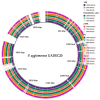Insights from a Genome-Wide Study of Pantoea agglomerans UADEC20: A Promising Strain for Phosphate Solubilization and Exopolysaccharides Production
- PMID: 39852170
- PMCID: PMC11763638
- DOI: 10.3390/cimb47010056
Insights from a Genome-Wide Study of Pantoea agglomerans UADEC20: A Promising Strain for Phosphate Solubilization and Exopolysaccharides Production
Abstract
The genome sequence of Pantoea agglomerans UADEC20 is presented, which is a strain isolated from agricultural fields in northeast Mexico. The genome was assembled into 13 scaffolds, constituting a total chromosome size of 4.2 Mbp, with two of the scaffolds representing closed plasmids. The strain exhibits activity in phosphate solubilization and exopolysaccharide (EPS) production and secretion; therefore, we explored its biotechnological potential via its genome sequencing and annotation. Genomic analyses showed that a total of 57 and 58 coding sequences (CDSs) related to phosphate solubilization and EPS production were identified within its genome, in addition to a reduced number of CDSs related to drug resistance and phages. The comprehensive set of genes supporting phosphate solubilization, EPS synthesis, and secretion, along with its low virulence and antibiotic resistance levels, justify further research for its potential biotechnological application and possible use as a plant growth-promoting agent in the field. These findings suggest a unique genetic background in the P. agglomerans UADEC20 strain.
Keywords: PGPR; Pantoea agglomerans; exopolysaccharide production; genome; phosphate solubilization.
Conflict of interest statement
The authors declare no conflicts of interest.
Figures






Similar articles
-
Comprehensive genomic analysis of a plant growth-promoting rhizobacterium Pantoea agglomerans strain P5.Sci Rep. 2017 Nov 15;7(1):15610. doi: 10.1038/s41598-017-15820-9. Sci Rep. 2017. PMID: 29142289 Free PMC article.
-
Genome Sequencing of Pantoea agglomerans C1 Provides Insights into Molecular and Genetic Mechanisms of Plant Growth-Promotion and Tolerance to Heavy Metals.Microorganisms. 2020 Jan 22;8(2):153. doi: 10.3390/microorganisms8020153. Microorganisms. 2020. PMID: 31979031 Free PMC article.
-
Whole genome sequencing and characterization of Pantoea agglomerans DBM 3797, endophyte, isolated from fresh hop (Humulus lupulus L.).Front Microbiol. 2024 Feb 8;15:1305338. doi: 10.3389/fmicb.2024.1305338. eCollection 2024. Front Microbiol. 2024. PMID: 38389535 Free PMC article.
-
Pantoea agglomerans: a mysterious bacterium of evil and good. Part IV. Beneficial effects.Ann Agric Environ Med. 2016 Jun 2;23(2):206-22. doi: 10.5604/12321966.1203879. Ann Agric Environ Med. 2016. PMID: 27294621 Review.
-
Opposite Sides of Pantoea agglomerans and Its Associated Commercial Outlook.Microorganisms. 2022 Oct 20;10(10):2072. doi: 10.3390/microorganisms10102072. Microorganisms. 2022. PMID: 36296348 Free PMC article. Review.
Cited by
-
Bioinformatics Research in Bacterial Genomics and Metagenomics.Curr Issues Mol Biol. 2025 Apr 8;47(4):258. doi: 10.3390/cimb47040258. Curr Issues Mol Biol. 2025. PMID: 40699657 Free PMC article.
-
Plasmid and chromosomal sequences of Pantoea agglomerans isolated from air in Fort Collins, Colorado.Microbiol Resour Announc. 2025 Jul 10;14(7):e0034125. doi: 10.1128/mra.00341-25. Epub 2025 Jun 9. Microbiol Resour Announc. 2025. PMID: 40488507 Free PMC article.
References
Grants and funding
LinkOut - more resources
Full Text Sources
Molecular Biology Databases
Miscellaneous

